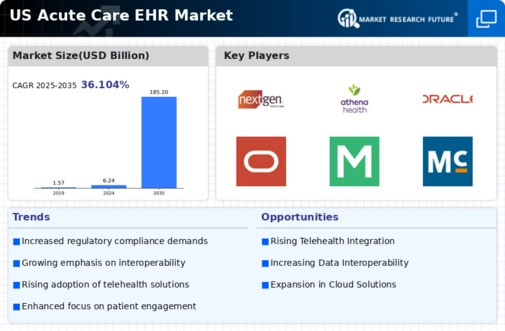Regulatory Compliance Pressure
The acute care-ehr market is experiencing heightened pressure from regulatory bodies to comply with various healthcare standards and regulations. This includes mandates from the Centers for Medicare & Medicaid Services (CMS) and the Office of the National Coordinator for Health Information Technology (ONC). Compliance with these regulations is crucial for healthcare providers to receive reimbursements and avoid penalties. As a result, many organizations are investing in advanced EHR systems that ensure adherence to these regulations. The market is projected to grow as providers seek solutions that not only meet compliance requirements but also enhance operational efficiency. This regulatory landscape is likely to drive innovation and investment in the acute care-ehr market, as organizations strive to maintain compliance while improving patient care.
Shift Towards Value-Based Care
The transition from fee-for-service to value-based care models is significantly influencing the acute care-ehr market. Healthcare providers are increasingly incentivized to improve patient outcomes while reducing costs, which necessitates the use of advanced EHR systems that can track and analyze patient data effectively. This shift is prompting organizations to invest in EHR solutions that support population health management and care coordination. Market data indicates that the value-based care segment is expected to grow at a CAGR of over 15% in the coming years. As providers adapt to these new reimbursement models, the acute care-ehr market is likely to see increased demand for systems that facilitate value-based care initiatives.
Rising Demand for Interoperability
Interoperability remains a critical driver in the acute care-ehr market, as healthcare providers increasingly seek systems that facilitate seamless data exchange across different platforms. The ability to share patient information among various healthcare entities is essential for coordinated care and improved patient outcomes. According to recent data, approximately 70% of healthcare organizations report that interoperability is a top priority for their EHR systems. This demand is pushing vendors to develop solutions that enhance connectivity and data sharing capabilities. As healthcare systems continue to evolve, the acute care-ehr market is likely to expand, driven by the need for integrated solutions that support interoperability and enhance care delivery.
Increased Focus on Patient-Centric Care
The acute care-ehr market is increasingly influenced by the growing emphasis on patient-centric care. Healthcare providers are recognizing the importance of engaging patients in their own care processes, which necessitates the use of EHR systems that support patient access to their health information. Features such as patient portals and mobile applications are becoming essential components of EHR solutions. Data suggests that organizations that prioritize patient engagement see improved health outcomes and higher patient satisfaction rates. As the healthcare landscape shifts towards a more patient-centered approach, the acute care-ehr market is likely to expand, driven by the demand for systems that enhance patient involvement and communication.
Technological Advancements in EHR Systems
Technological advancements are playing a pivotal role in shaping the acute care-ehr market. Innovations such as cloud computing, mobile access, and advanced analytics are enhancing the functionality and usability of EHR systems. These technologies enable healthcare providers to access patient information in real-time, improving decision-making and care delivery. Furthermore, the integration of machine learning and predictive analytics is allowing for more personalized patient care. As healthcare organizations seek to leverage these advancements, the acute care-ehr market is expected to witness substantial growth. The ongoing evolution of technology in EHR systems is likely to drive competition among vendors, leading to more sophisticated solutions that cater to the needs of healthcare providers.






















Leave a Comment